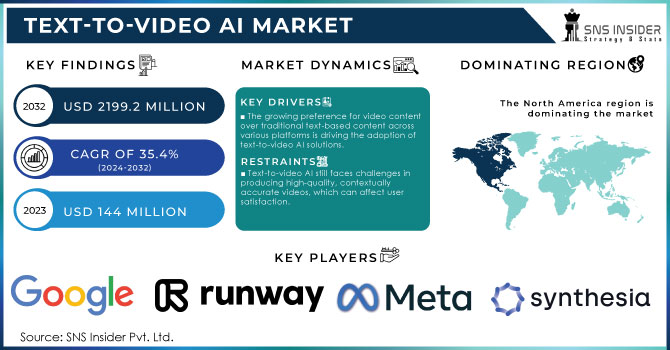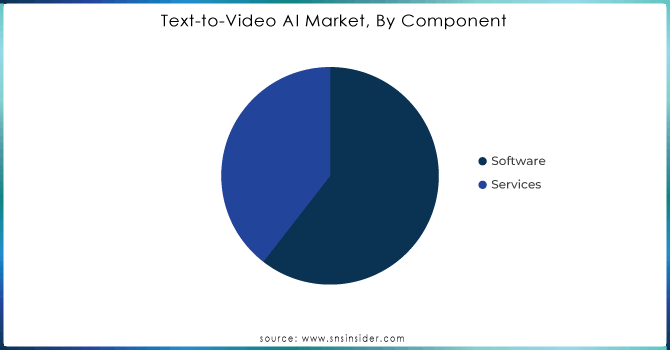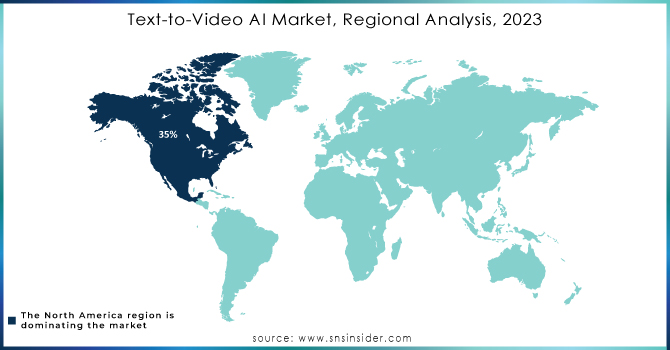Text-to-Video AI Market Report Scope & Overview:

Get More Information on Text-to-Video AI Market - Request Sample Report
Text-to-Video AI Market Size was valued at USD 144 Million in 2023 and is expected to reach USD 2199.2 Million by 2032, growing at a CAGR of 35.4 % over the forecast period 2024-2032.
The Text-to-Video AI market is booming due to rapid advances in artificial intelligence and growing interest in automated content creation technologies. According to recent data from the U.S. Department of Commerce, the AI industry will exceed the $500 billion mark by 2025, and a significant portion will come from innovative systems, such as text-to-video AIs. Market growth primarily results from the increasing demand for engaging and personalized content on digital platforms. The Federal Communications Commission stated that video content presently comprises over 80% of global internet traffic, increasing the appeal and need for rapid video production strategies. Additionally, government incentives for tech startups and investments in AI research are accelerating market expansion. For instance, the National Science Foundation (NSF) recently announced a $300 million grant to support AI development, further boosting the adoption of text-to-video technologies. Overall, the future of the Text-to-Video AI market is favorable, as the widespread adoption of these tools in diverse fields drives market growth steadily.
One key driver for the Text-to-Video AI market is the growing need for dynamic content production in marketing and entertainment. Due to the progression and development of recent AI models such as GPT-4 and DALL-E, textual descriptions can be seamlessly generated in the form of high-quality video content. With the growing need for personalization, tools like Synthesia and Pictory enable brands to film cost-effective and scalable customized video ads from mere text inputs. This ground-breaking technology creates films that match the content of the supplied text using Natural Language Processing and computer vision techniques. Additionally, this novel technology facilitates the integration of video ads into various sectors, such as e-learning and virtual events, promoting more immersive and engaging experiences.
Market Dynamics
Drivers
-
The growing preference for video content over traditional text-based content across various platforms is driving the adoption of text-to-video AI solutions.
-
Text-to-video AI tools reduce the time and cost associated with video production by automating the creation of video content from textual input.
-
The growth of e-learning platforms and remote work environments increases the need for engaging video content, which text-to-video AI can facilitate.
The text-to-video AI market is growing with the increasing popularity of video content across all digital platforms. The recent statistics confirm this trend with video content leading in user engagement and usage. According to a recent 2023 report, 87% of businesses use video content for marketing purposes, reflecting a 10% increase from 2022. Besides, over 80% of online content consumed by users is video-based. The shift towards video content can be attributed to its effectiveness in capturing attention and conveying information more engagingly than text alone. Such platforms as YouTube or TikTok witnessed an enormous growth rate with YouTube 2.5 billion monthly logged-in users and TikTok 1 billion monthly active users at the beginning of 2024, according to recent data. This is true for social media marketing also, with 48% of users more willing to share video, and 29% to like it compared to text posts, as reported by the Social Media Examiner in 2023. Such growing demand for text-to-video AI, which allows to automation of the video creation process and produces large amounts of various videos with informationally-rich content. For example, companies like Synthesia or Lumen5 benefit from the growing demand and supply customers with various tools to produce content quickly from the outlines or texts the customer provides.
Restraints
-
Text-to-video AI still faces challenges in producing high-quality, contextually accurate videos, which can affect user satisfaction.
-
The processing power required for generating videos from text can be significant, leading to higher costs and resource demands.
-
Text-to-video AI systems may struggle with understanding complex language nuances and context, which can lead to less effective video content.
-
The use of text-to-video AI involves processing large amounts of data, raising concerns about data privacy and security.
One of the key factors limiting the expanded and massive use of text-to-video AI technology is the difficulty in producing high-quality videos. The technology involves the process of translating descriptions of typesetting video into reality, which is a difficult task. Video production requires an understanding of the context or the use of specific graphic techniques. However, accurately understanding lines from the script is a difficult task. Thus, the resulting video lacks some context or graphic delights, such as images on an airplane window, which can negatively affect quality. Depending on the task, some details may be more important than others. In this way, the contradictory and ambiguous nature of connecting text and video, as well as the specifics of human perception in the relationship of written and visual information, can be a serious hindrance to the formation of the mass usage of this technology.
Segment analysis
By Component
The software segment held more than 58% of the market in 2023. This considerable market share is to be attributed to the growing interest in advanced software solutions, which allow rapid, efficient, and automated video production. Government data presented by the Bureau of Economic Analysis indicates a booming growth of the software sector resulting from technological advancements and increased deployment of AI solutions. For instance, according to the U.S. Department of Labor, the demand for software solutions to facilitate their AI applications has grown by more than 30% per annum. Moreover, the software category encompasses various types of tools and platforms that can provide users with increased flexibility and efficiency compared to traditional methods when converting on-demand text into ready-to-use video content. Hence, as organizations and businesses keep actively improving their ability to craft content, this segment’s market share is expected to continue growing due to the demand for highly functional and robust solutions.
The services segment is expected to show a much faster rate of growth due to the high demand for customized solutions and ongoing support from service providers. Government data supported by Better Business Economics indicate that the services sector, which includes consulting, technical support, and various types of on-site services, contributes heavily to the growth of the tech sector as a whole. The deployment of a text-to-video AI heavily relies on various types of services, including integration, training, and maintenance. Such services are crucial for organizations to fully realize the benefits and functionalities of the technology.

Do You Need any Customization Research on Text-to-Video AI Market - Enquire Now
By End User
Marketers is the largest segment in the Text-to-Video AI market, accounted more than 35% of the market in 2023. The reason for this prominent presence is the increased utilization of video content within marketing strategies. As the U.S. Small Business Administration points out, 70% of individuals working as marketers create and apply video materials as part of their digital promotion campaigns. Therefore, the solutions that are introduced by text-to-video AI manufacturers have less to do with the fact that the software helps create engaging video materials and more with the unique opportunities that marketers have in terms of enhancing the number of campaigns and broadening the range of audiences. At present, social media managers, educators, content creators, and corporate workers use these technologies widely, but the emphasis on video campaigns and their highly dynamic development accounts for marketers staggering share of the market. The FTC’s statistics show that the country’s digital advertising spending has increased without viable alternatives to high-quality video.
Regional Analysis | North America Dominant Region in 2023
In 2023, the leading region in the Text-to-Video AI market was North America, which held a major share of 35%. This dominance can be attributed to the region's advanced technological infrastructure, high adoption rates of AI technologies, and significant investments in AI research and development. The Census Bureau also states that North America is the top continent in AI adoption. The area dominates in terms of government funding and private-sector investments. The market is also augmented by a consolidated tech ecosystem represented by multiple technologically advanced companies. These companies are leaders in the development and implementation of the solutions in question. In addition, public sector supports also affect the market. for instance, the AI Research and Development Act includes a provision allocating funds to the further development of AI technologies. Thus, the well-established presence of high technology on the market and significant demand for AI technologies makes North America the world’s leader in Text-to-Video AI.
The Asia Pacific region has been expanding with significat CAGR during forecast period of 2024-2032. When it comes to technological development and the adoption of AI, Research and development in AI has received significant funding from nations including China, Japan, South Korea, and India. Due to its huge investments in AI technology, major tech businesses, and government support for AI efforts, China might be regarded as one of the leading nations in the Asia Pacific. Particularly in nations with well-established tech ecosystems like China, Japan, and South Korea, major players in the Text to Video AI market may hold a sizable market share. As businesses and sectors try to use AI for a variety of purposes, including content creation, the Asia Pacific area may be seeing an increase in the adoption rate of Text to Video AI solutions.

KEY PLAYERS
-
Runway (Gen-2 AI Video Generator, Gen-1 Video-to-Video)
-
Meta (Facebook AI) (Make-A-Video, Meta Transformer Video Models)
-
Google Research (Imagen Video, Phenaki)
-
Synthesia (AI Video Creator, Custom AI Avatars)
-
Pictory (Script-to-Video, AI Video Editor)
-
DeepBrain AI (AI Studios, Realistic AI Avatars)
-
Lumen5 (Blog-to-Video, Social Media Video Maker)
-
GliaCloud (GliaStudio, AI Video News Generator)
-
InVideo (AI Text-to-Video Creator, Video Ad Maker)
-
Veed.io (Auto Subtitles, AI Video Generator)
-
Vidioh (AI Explainer Videos, Social Media Video Maker)
-
Hour One (AI Video Presenter, Professional Human Avatars)
-
Synthesys (AI Video Maker, Realistic Voiceover for Video)
-
Elai.io (AI Video Presentations, Text-to-Video Generator)
-
FlexClip (AI Explainer Video, AI Marketing Videos)
-
Designs.ai (Video Maker, Logo Animation Creator)
-
Animoto (Text-to-Social Media Video, Marketing Video Creator)
-
Kapwing (Auto-Video Generator, AI-powered Video Editing)
and other players in final report.
RECENT DEVELOPMENTS
-
In September 2024, the U.S. Department of Commerce announced a new investment to promote opportunities through technology development in the sphere of AI. It is planned to provide $250 million to support those developing and advancing AI technologies, including text-to-video AI. Increased innovation and commercialization may lead to further growth and application of text-to-video technologies in various industries.
-
In August 2024, the National Institute of Standards and Technology published updated guidelines for AI projects, including text-to-video systems, and their operation. The purpose of the guidelines is to ensure the responsible development and use of AI solutions and develop common industry standards and practices.
-
In July 2024, the Federal Trade Commission released a report on the impact of AI technologies on digital marketing and advertising. It states that more and more advertisers resort to text-to-video AI, which helps to create content to change the face of advertising. This trend allows for developing various advertising strategies at a new level.
-
In July 20, 2023, Vimeo.com, Inc. announced that it is partnering with De-Identification Ltd. to offer a new text-to-video AI service called "Vimeo Video Maker." This service will allow users to create videos from text by simply providing a script or a blog post. Vimeo Video Maker uses De-Identification Ltd.'s AI technology to generate realistic and engaging videos, even if the text is complex or technical.
-
In July 13, 2023, Meta Platforms, Inc. announced that it is developing a new text-to-video AI feature for its Facebook platform. This feature will allow users to create videos from text by simply dictating their thoughts into a microphone. Meta Platforms' AI technology will then generate a video based on the user's dictation.
| Report Attributes | Details |
| Market Size in 2023 | USD 144 Million |
| Market Size by 2032 | USD 2499.2 Million |
| CAGR | CAGR of 35.4% From 2024 to 2032 |
| Base Year | 2023 |
| Forecast Period | 2024-2032 |
| Historical Data | 2020-2022 |
| Report Scope & Coverage | Market Size, Segments Analysis, Competitive Landscape, Regional Analysis, DROC & SWOT Analysis, Forecast Outlook |
| Key Segments | • By Component (Software, Services) • By Organization Size (Large Enterprises, Small- & Medium-Sized Enterprises) • By Deployment Mode (On-premises, Cloud) • By End User (Marketers, Social Media Managers, Content Creators, Corporate Professionals, Educators & Course Creators , Others) • By Vertical (Education, Food & Beverages, Media & Entertainment, Fashion & Beauty, Retail & Ecommerce, Health & Wellness, Travel & Hospitality, Real Estate, Others) |
| Regional Analysis/Coverage | North America (US, Canada, Mexico), Europe (Eastern Europe [Poland, Romania, Hungary, Turkey, Rest of Eastern Europe] Western Europe] Germany, France, UK, Italy, Spain, Netherlands, Switzerland, Austria, Rest of Western Europe]). Asia Pacific (China, India, Japan, South Korea, Vietnam, Singapore, Australia, Rest of Asia Pacific), Middle East & Africa (Middle East [UAE, Egypt, Saudi Arabia, Qatar, Rest of Middle East], Africa [Nigeria, South Africa, Rest of Africa], Latin America (Brazil, Argentina, Colombia Rest of Latin America) |
| Company Profiles | Vimeo.com, Inc., Meta Platforms, Inc., De-Identification Ltd., Google LLC, Synthesia Limited, Veed Limited, Movio, Yepic AI Limited, Animatron, Inc., Ezoic, Inc. |
| Key Drivers | • The growing preference for video content over traditional text-based content across various platforms is driving the adoption of text-to-video AI solutions. • Text-to-video AI tools reduce the time and cost associated with video production by automating the creation of video content from textual input. |
| Market Restraints | • Text-to-video AI still faces challenges in producing high-quality, contextually accurate videos, which can affect user satisfaction. • The processing power required for generating videos from text can be significant, leading to higher costs and resource demands. |

